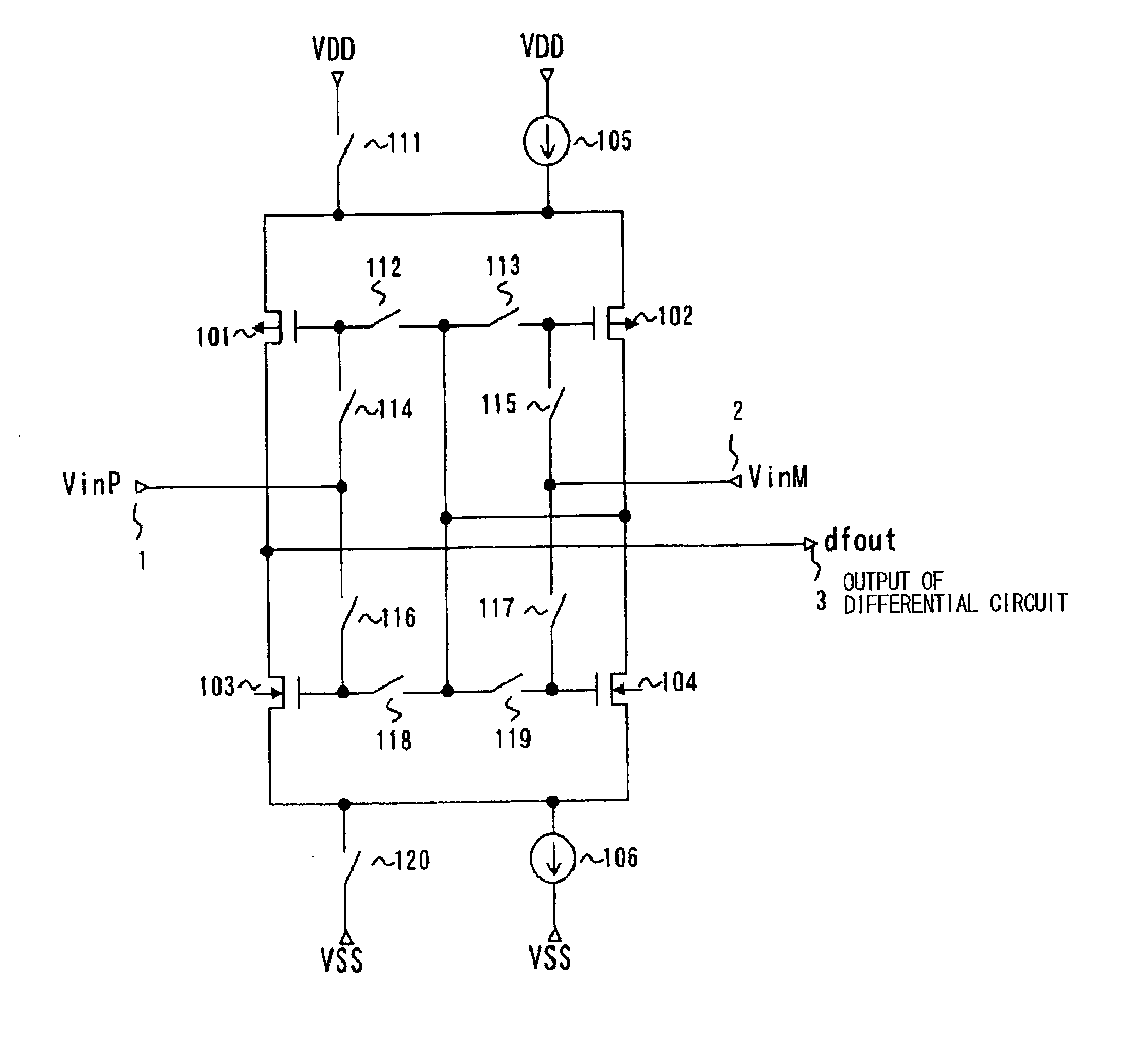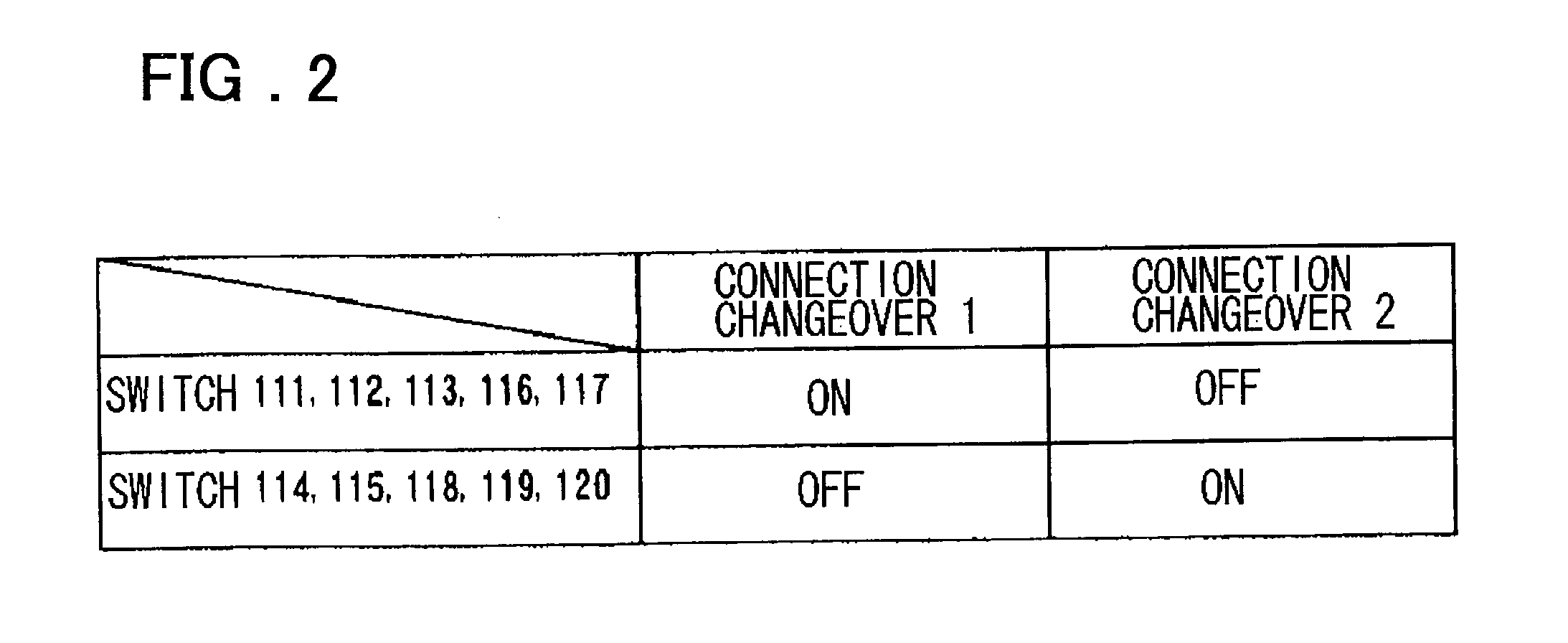Differential circuit, amplifier circuit, driver circuit and display device using those circuits
a technology of driver circuit and output, which is applied in the direction of gated amplifier, static indicating device, instruments, etc., can solve the problems of reducing and affecting the output output output, so as to reduce the deviation of the amplitude difference and reduce power consumption
- Summary
- Abstract
- Description
- Claims
- Application Information
AI Technical Summary
Benefits of technology
Problems solved by technology
Method used
Image
Examples
first embodiment
[0138] Some examples of the present invention will be described with reference to the drawings to describe more in detail the embodiments of the present invention described above. FIG. 1 is a diagram showing the configuration of the present invention.
[0139] Referring to FIG. 1, a differential circuit in this embodiment comprises a pair of p-channel transistors 101 and 102 and a pair of n-channel transistors 103 and 104. The sources of the paired p-channel transistors 101 and 102 are coupled together and, between the commonly coupled sources of the paired p-channel transistors and the high-potential power supply VDD, there are provided a switch 111 and a constant-current source 105 which are connected in parallel. Switches 112 and 113 are connected in series between the gates of the paired p-channel transistors 101 and 102. The drains of the p-channel transistor pair 101 and 102 are connected to the drains of the paired n-channel transistors 103 and 104.
[0140] The sources of the n-ch...
second embodiment
[0161] FIG. 4 is a diagram showing the configuration of the present invention. This figure shows an example of the configuration of the differential circuit shown in FIG. 1 in which the switches are configured by MOS transistors. In FIG. 4, switch control signals S1 and S2 are controlled by the low level (L) or high level (H).
[0162] The circuit enters the connection changeover 1 state by controlling the signals such that (S1, S2)=(H,L), and the circuit enters the connection changeover 2 state by controlling the signals such that (S1, S2)=(L,H). S1B and S2B are the inverted signals of S1 and S2.
[0163] Each switch may be any switch that may be connected and disconnected. FIG. 4 shows the configuration that requires less transistors (reduction in the number of devices) and less space. First, a switch 111 and a switch 120, one end of which is connected to the high-potential power supply VDD and the low-potential power supply VSS, may be configured respectively by a single p-channel tran...
third embodiment
[0168] Next, another embodiment of the present invention will be described. FIG. 5 is a diagram showing the configuration of the present invention. FIG. 5 shows the configuration of a driver circuit configured by using the differential circuit in FIG. 1. That is, a differential circuit in FIG. 5, which comprises transistors 101, 102, 103, and 104, switches 111-120, and current sources 105 and 106, is the same as the one shown in FIG. 1. FIG. 6 shows an example of how the driver circuit in FIG. 5 is controlled.
[0169] Referring to FIG. 5, this driver circuit is a feedback type amplifier circuit including two amplification stages 510 and 520 that operate in response to an output from the differential circuit shown in FIG. 1. Referring to FIG. 5, an input voltage Vin (input voltage VinP in FIG. 1) and an output voltage Vout (input voltage VinM in FIG. 1) are sent to the two input terminals (differential input terminals) of the differential circuit.
[0170] The amplification stage 510 is a...
PUM
 Login to View More
Login to View More Abstract
Description
Claims
Application Information
 Login to View More
Login to View More - R&D
- Intellectual Property
- Life Sciences
- Materials
- Tech Scout
- Unparalleled Data Quality
- Higher Quality Content
- 60% Fewer Hallucinations
Browse by: Latest US Patents, China's latest patents, Technical Efficacy Thesaurus, Application Domain, Technology Topic, Popular Technical Reports.
© 2025 PatSnap. All rights reserved.Legal|Privacy policy|Modern Slavery Act Transparency Statement|Sitemap|About US| Contact US: help@patsnap.com



